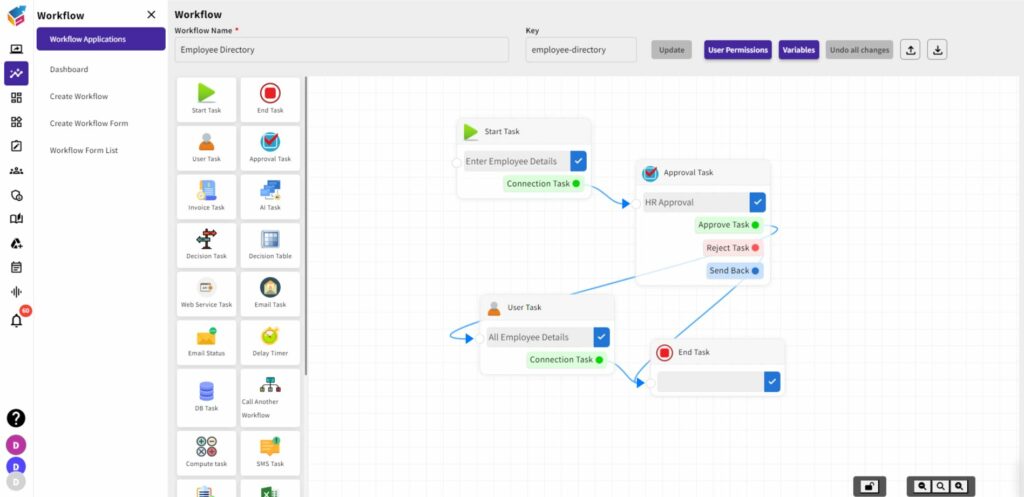Table of Contents
Why Is Workflow Automation Important?
Workflow automation is revolutionizing the business industry by helping organizations save costs and improve employee productivity. A Forbes report reveals that organizations implementing workflow automation in their business processes saw a 28% uptick in year-over-year revenue. With a dynamic workflow management software system in place, businesses can eliminate manual tasks and reduce errors while simultaneously improving transparency and overall work culture. Regardless of its overwhelming benefits, many businesses still find workflow automation to be a tad daunting. That is why some of them choose to stick with paper-based processes. A separate Forbes report shows that roughly 55% of businesses still use paper-based documents in their everyday operations. In this article, we’ll outline the challenges of workflow management system implementation and provide you with simple yet effective tips to overcome them.
Employee Resistance
Employee resistance is perhaps one of the most recalcitrant and baffling issues business executives face when implementing workflow and process automation to their processes. Usually, leaders find their employees requesting for transfers or even worse, quitting because of workflow process changes. This is because most employees fear that technological advancements such as task management workflow solutions can make their jobs even more complicated. An excellent way to resolve this nagging problem is to be transparent with employees on why and how workflow automation is happening. Through constant communication, leaders can reduce the employees’ fear of the unknown and ensure that their concerns are addressed. You should also highlight how workflow automation will make their jobs easier and reduce workflow problems to keep them engaged at every step of the implementation process.
Bad Experience with Technology
Bad experience with previous tech adoption is another reason why most individuals, especially those in the education sector tolerate manual processes. Usually, leaders find themselves thinking of that time wherein employees struggled to adapt to technology the moment a technological advancement like workflow automation hits their radar. However, this thinking can do more harm than good to your operations and may set you back in achieving growth, especially nowadays wherein technology is at the core of every work environment. One way to get over terrible technology experiences is to conduct comprehensive training initiatives to ease implementation and address concerns. You can send out software training guides or use top apps for teachers regarding workflow automation training if you operate in the education sector to ensure seamless adoption. By making training a priority, you can improve buy-in and enhance enthusiasm among members who are resistant to change.
Privacy and Security Concerns
As the pandemic generates a new breed of online criminals, most business leaders often stick with manual processes to prevent online data theft. After all, manual workflows only depend on physical security which means that they do not have to learn how to combat emerging hacking techniques. While doing so may protect businesses in the short-term, it does not excuse them of the risks such as data loss and potential downtime. Therefore, you must ensure that your chosen workflow management tool is brimming with innovative security features to protect the data you collect. A rule of thumb is to ensure that the solution has top workflow automation features such as database encryption, password protection, and workflow tracking. This way, you can identify real-time workflow status and pinpoint and resolve threats immediately.
Vague Understanding of Existing Workflows
The lack of understanding of existing enterprise workflows also prevents the implementation of automated technology. Before workflows can be transferred online, you must arrange the entire process to guarantee that numerous leads trigger the right sequential actions. This can be critical, especially if you are planning to initiate an overhaul of your workflows at once. Although most organizations generally understand their workflows, it is not uncommon for them to take for granted or completely forget the steps they took in the online transition. That said, you should have nuanced descriptions when implementing workflow automation to your processes to prevent ambiguity which can adversely affect final workflow outcomes.
Finding the Right Solution
Choosing the right workflow automation tool is a small yet crucial step that could determine operational success. The challenge with selecting a workflow automation solution is that every provider in the market always has a list of checkmarks describing how their software is a cut above the rest. One way to narrow options and find the right solution is to map out your existing workflow.

Usually, workflow automation providers design their software around a problem that needs to be managed or a specific business issue. That said, ask providers for a comprehensive product demonstration to determine how your chosen software will solve your pain points. This way, you can ensure that the solution will fit perfectly with your company vision, resulting in a smooth implementation process.
Ensuring Higher Productivity and Reducing Costs through Workflow Automation
Achieving higher productivity at reduced costs is vital in helping organizations grow in a cutthroat business environment that requires everyone to maximize usage of available resources. One way of doing that is using workflow automation software solutions such as Yoroflow which helps organizations create automated business processes.




